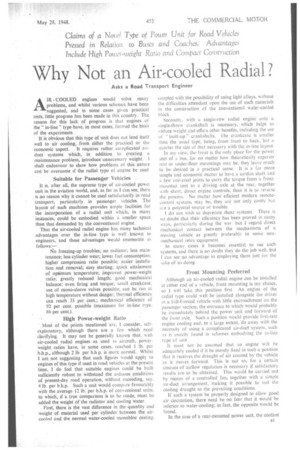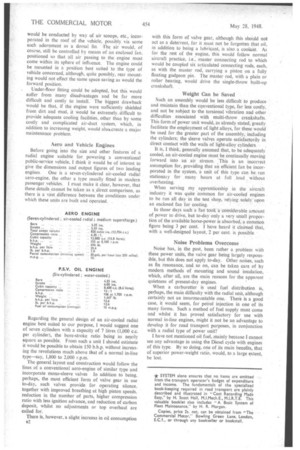Why Not an Air-cooled Radial?
Page 35

Page 36

If you've noticed an error in this article please click here to report it so we can fix it.
Asks a Road Transport Engineer Claims of a Novel Type of Power Unit for Road Vehicles Pressed in Relation to Buses and Coaches. Advantages Include High. Power-weight Ratio and Compact Construction AIR COOLED engines would solve many problems, and whilst various schemes have been suggested, and in some cases given practical tests, little progress has been made in this country. The reason for this lack of progress is that engines of the " in-line " type have, in most cases, formed the basis of the experiments.
It is obvious that this type of unit does not lend itself well to air cooling, from either the practical or the
economic aspect. It requires rather complicated airduct systems which, in addition to creating a maintenance problem, introduce unnecessary weight. I shall endeavour to show how problems of this nature can be overcome if the radial type of engine be used Suitable for Passenger Vehicles It is. after all, the supreme type of air-cooled power unit in the aviation world, and, as far as I can see, there is no reason why it cannot be used satisfactorily in road transport, particularly, in passenger vehicles. The layout. of such machines provides ample facilities for the incorporation of a radial unit which, in many instances, could be embodied within a smaller space than that demanded by the conventional engine.
That the air-cooled radial engine has many technical advantages over the in-line type is well , known to engineers, and these advantages would enumerate as follows:— 1%7o freezing-up troubles; no radiator; less maintenance; less cylinder wear; lower fuel consumption: higher compression ratio possible; easier installation and removal; easy starting; quick attainment of optimum temperature; improved power-weight ratio; greatly reduced length; good mechanical balance; even firing and torque; small crankcase; use of mono-sleeve valves possible; can be run at high temperature without danger; thermal efficiency can reach 33 per cent.; mechanical efficiency of 92 per cent. possible (maximum for in-line type. 86 per cent.).
High Power-weight Ratio Most of the points mentioned are, I consider, selt • explanatory, although there are a few which need clarifying. It may not be generally known that, with air-cooled radial engines as used in aircraft, powerweight ratios have, in some cases, reached I lb. per b.h.p., although 2 lb. per b.h.p. is more normal. Whilst I am not suggesting that such figures would apply to engines of this type if used in road vehicles at the present time, I do feel that suitable engines could be built sufficiently robust to withstand the arduous conditions of present-day road operation, without exceeding, say. 4 lb. per b.h.p. Such a unit would compare favourably with the average 12 lb. per b.h.p. of conventional units, to which, if a true comparison is to be made, must he added the weight of the radiator and cooling water.
First, there is the vast difference in the quantity and weight of material used per cylinder between the aircooled and the normal water-cooled monobloc casting. coupled with the possibility of using light alloys, without the difficulties attendant upon the use of such materials in the construction of the conventional water-cooled block.
Secondly, with a single-row radial engine only a single-throw crankshaft is necessary, which helps to reduce weight and offers other benefits, including the use of " built-up " crankshafts. I he crankcase is smaller than the usual type, being, from front to back, but a quarter the size of that necessary with the in-line layout
In my view, the front is the only place for the •power unit of a bus, for no matter how theoretically superior rear or under-floor mountings may be, they leave much to be desired in a practical sense. It is a far more simple and economic matter to have a cardan shaft and a few universal joints to carry the torque from a frontmounted unit to a driving axle at the rear, together
with short, direct engine controls, than it is to reverse the process. No matter how efficient modern remotecontrol systems may be, they are not only costly but are a potential source or trouble.
1 do not wish to deprecate these systems. There is no doubt that their efficiency has been proved in many
ways, particularly during the war. but I regard direct mechanical contact between the mechanisms of a moving vehicle as greatly preferable to some nonmechanical relay equipment In many cases it becomes essential to use such systems, and there is no doubt they do the job well, but I can see no advantage in employing them just for the sake of so doing.
Front Mounting Preferred Although an air-cooled radial engine can be installed at either end of a vehicle, front mounting is my choice, so I will take this position first An engine of the radial type could well be installed alongside the driver in a full-fronted vehicle with little encroachment on the passenger section, the entrance to which would probably be immediately behind the power unit and forward of the front axle. Such a position would provide first-rate engine cooling and, to a large extent, do away with the necessity of using a complicated air-duct system, such as is usually found in schemes embodying the in-line type of unit
It must not be assumed that an engine will be adequately cooled if it be merely fixed in such a position that it receives the draught of air created by the vehicle as it moves forward. This is not so, for a certain amount of airflow regulation is necessary if satisfactory results are to be obtained. This would be carried out by means of a controlled fan, together with a simple air-duct arrangement, making it possible to suit the cooling draught to the prevailing conditions.
If such a system be properly designed to allow good air circulation, there need be no fear that it would be inferior to water-cooling; in fact, the opposite would be found.
In the case of a rear-mounted power unit, the coolant. would be conducted by way of air scoops, etc., incorporated in the roof of the vehicle, possibly via some such adornment as a dorsal fin. The air would, of course, still be controlled by means of an enclosed fan. positioned so that all air passing to the engine must come within its sphere of influence. The engine could be mounted in a position best suited to the type of vehicle concerned, although, quite possibly, rear mounting would not effect the same space saving as would the forward position.
Under-floor fitting could be adopted, but this would suffer from many disadvantages and be far more difficult and costly to install. The biggest drawback would be that, if the engine were sufficiently shielded from dirt and mud, it would be extremely.difficult to provide adequate cooling facilities, other than by some costly and complicated air-duct system, which, in addition to increasing weight, would alsobcreate a major maintenance problem.
Aero and Vehicle Engines Before going into the size and other features of a radial engine suitable for powering a conventional public-service vehicle, I think it would be of interest to give the dimensions and output figures of two leading engines. One is a seven-cylindered air-cooled radial aero-engine, the other a type usually fitted in modern passenger vehicles. I must make it clear, however, that these details. cannot be taken as a.direct comparison, as there is a vast difference between the conditions under which these units are built and operated.
Regarding the general design of art air-cooled radial engine best suited to our purpose, I would suggest one of seven cylinders with a capacity of 7 litres (1,000 c.c. per cylinder), the bore-stroke ratio being as nearly square as possible. From such a unit I should estimate it would be possible to obtain 150 b.h.p. without increasing the revolutions much above that of a normal in-line type—say, 1,800 to 2,000 r.p.m.
The-general layout and construction would follow the lines of a conventional aero-engine of similar type and incorporate mono-sleeve valves In addition to being. perhaps, the most efficient form of valve gear in use to-day, such valves provide for operating silence, together with improved breathing at high piston speeds. reduction in the number of parts, higher compression ratio with less ignition advance, and reduction of carbon deposit, whilst no adjustments or top overhaul are called for.
There is, however, a slight increase in oil consumption 82
with this form of valve gear, although this should not act as a deterrent, for it must not be forgotten that oil, in addition to being a lubricant, is also a coolant. As for the rest of the engine, this would follow normal aircraft practice, i.e., master connecting rod to which would be coupled six articulated connecting rods, each, as with the master rod, carrying a piston on a fully floating gudgeon pin. The master rod, with a plain or roller bearing, would drive the single-throw, built-up crankshaft.
Weight Can be Saved
Such an assembly would be less difficult to produce andmaintain than the conventional type, far less costly, and not be subject to the torsional vibration and other difficulties associated with multi-throw crankshafts. This form of power unit would, as already stated, greatly facilitate the employment of light alloys, for these would be used for the greater part of the assembly, including the cylinders; the sleeve valves operate satisfactorily in direct contact with the walls of light-alloy cylinders
It is, I think, generally assumed that, to be adequately cooled, an air-cooled engine must be continually moving forward into an air stream. This is an incorrect assumption for, providing that an efficient fan be incorporated in the system, a unit of this type can be run stationaly for. many hours at full .load without overheating.
When serving my apprenticeship in the aircraft industry it was quite common for air-cooled engines to be run all day in the test shop, relying solely' upon an enclosed fan for cooling. . •
In those days such a fan took a considerable amount of power to drive, but to-day only a very small proportion of the available horse-power is absorbed, a common figure being 3 per cent. I have heard it claimed that, with a well-designed layout, 2 per cent. is possible Noise Problems Overcome Noise has, in the past, been rather a problem with these power units, the valve gear being largely responsible, but this does not apply to-day. Other noises, such as fin resonance, and so on, can be taken care of by modern methods of mounting and sound insulation, which, after all, are the main reasons for the apparent quietness of present-day engines.
When a carburetter is used fuel distribution is, perhaps, the main difficulty with the radial unit, although certainly not an insurmountable one. There is a good case, it would seem, for petrol injection in one of its many forms. Such a method of fuel supply must come and whilst it has proved satisfactory for use with normal in-line engines, might it not be an advantage to develop it for road transport purposes, in conjunction with a radial type of power unit?
I have not mentioned oil fuel, mainly because I cannot see any advantage in using the Diesel cycle with engines of this type. By so doing, one of its main benefits, that of superior power-weight ratio, would, to a large extent, be lost.




















































































